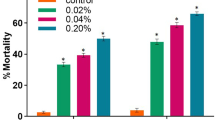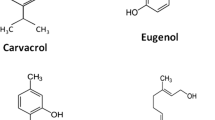Abstract
Bioassays were developed and applied to test the role of eicosanoids and pH changes in ecdysis of Oesophagostomum dentatum. Exsheathment (80–100%) was achieved by subjecting third-stage larvae (L3) either to chlorine (hypochlorite assay) for 5 min or by incubating them in HCl followed by addition of NaHCO3 (pH-change assay) with subsequent cultivation at 38.5°C/10% CO2 for 1 week. Addition of the lipoxygenase (LOX) inhibitor diethylcarbamacine (DEC) to the larvae resulted in a reduction of the exsheathment rates which could be restored by the addition of leukotrienes (LT)B4, LTC4, LTD4 and LTE4. Addition of the cyclooxygenase (COX) inhibitor acetylsalicylic acid (ASA) also resulted in decreased exsheathment rates both in the hypochlorite and in the pH-change assays in a dose-dependent manner. However, the primary COX products (prostaglandins) were not able to reverse this effect, in contrast to LTC4. It was concluded that: (1) both tests are suitable for bioassaying the effect of substances on exstheathment, and (2) eicosanoids involved in the control of exhseathment of L3 of O. dentatum are primarily LT.





Similar content being viewed by others
References
Conder GA, Johnson SS (1996) Viability of infective larvae of Haemonchus contortus, Ostertagia ostertagi, and Trichostrongylus colubriformis following exsheathment by various techniques. J Parasitol 8:100–102
Daugschies A (1995) Oesophagostomum dentatum: population dynamics and synthesis of prostanoids by histotropic stages cultured in vitro. Exp Parasitol 81:574–583
Daugschies A (1996) Investigations into the production and function of leukotrienes during histotropic development of Oesophagostomum dentatum. Parasitol Res 82:416–422
Daugschies A, Joachim A (2000) Eicosanoids in parasites and parasitic infections. Adv Parasitol 46:181–240
Daugschies A, Ruttkowski B (1998) Modulation of migration of Oesophagostomum dentatum larvae by inhibitors and products of eicosanoid metabolism. Int J Parasitol 28:355–362
Douvres FW, Thompson DE (1973) Histochemical distribution of “leucine” aminopepetidase in Oesophagostomum radiatum grown in vivo and in vitro. J Parasitol 59:417–424
Eckert J (1967) In vitro Entwicklung invasionsfähiger Nematoden-Larven zu parasitischen Stadien. Z Parasitenkd 29:242–274
Frandsen JC, Bone LW (1989) Prostanoids of nematodes: prostaglandins and thromboxane B2 from Trichostrongylus colubriformis and Turbatrix aceti. Comp Biochem Physiol C, Comp Pharmacol Toxicol 92:185–187
Gamble HR, Purcell JP, Fetterer RH (1989) Purification of a 44 kilodalton protease which mediates the ecdysis of infective Haemonchus contortus larvae. Mol Biochem Parasitol 33:49–58
Hertzberg H, Huwyler U, Kohler L, Rehbein S, Wanner M (2002) Kinetics of exsheathment of infective ovine and bovine strongylid larvae in vivo and in vitro. Parasitology 125:65–70
Patel MR, Campbell WC (1997) Enhanced ability of third-stage larvae of Haemonchus contortus to withstand drug exposure following chemically induced exsheathment. J Parasitol 83:971–973
Rogers WP (1970) The function of leucine aminopeptidase in exsheathing fluid. J Parasitol 56:138–143
Rogers WP (1982) Enzymes in the exsheathing fluid of nematodes and their biological significance. Int J Parasitol 12:495–502
Rogers WP, Brooks F (1976) Zinc as a co-factor for an enzyme involved in exsheathment of Haemonchus contortus. Int J Parasitol 6:315–319
Silverman PH, Podger KR (1964) In vitro exsheathment of some nematode infective larvae. Exp Parasitol 15:314–324
Slocombe JO, Whitlock JH (1970) The development of a standard method for rapid ecdysis of infective Haemonchus contortus cayugensis larvae. J Parasitol 61:273–277
Sommerville RI (1957) The exsheathing mechanism of nematode infective larvae. Exp Parasitol 6:618–630
Talvik H, Christensen CM, Joachim A, Roepstorff A, Bjørn H, Nansen P (1997) Prepatent periods of different Oesophagostomum spp. isolates in experimentally infected pigs. Parasitol Res 83:563–568
Zhan B, Hotez PJ, Wang Y, Hawdon JM (2002) A developmentally regulated metalloprotease secreted by host-stimulated Ancylostoma caninum third-stage infective larvae is a member of the astacin family of proteases. Mol Biochem Parasitol 120:291–296
Author information
Authors and Affiliations
Corresponding author
Rights and permissions
About this article
Cite this article
Joachim, A., Ruttkowski, B. & Daugschies, A. Ecdysis of Oesophagostomum: possible involvement of eicosanoids and development of a bioassay. Parasitol Res 95, 391–397 (2005). https://doi.org/10.1007/s00436-005-1302-1
Received:
Accepted:
Published:
Issue Date:
DOI: https://doi.org/10.1007/s00436-005-1302-1




